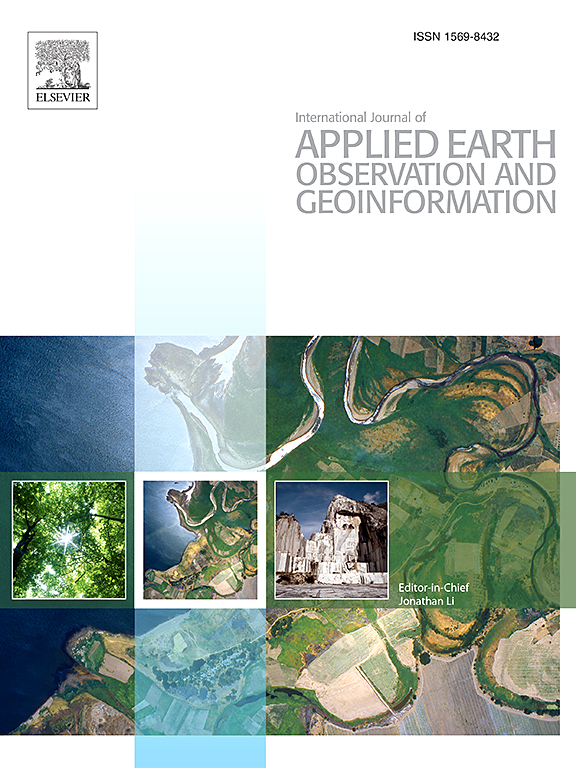Delineating flood susceptibility zones using novel ensemble models – An application of evidential belief function, relative frequency ratio, and Shannon entropy
IF 7.6
Q1 REMOTE SENSING
International journal of applied earth observation and geoinformation : ITC journal
Pub Date : 2025-06-14
DOI:10.1016/j.jag.2025.104669
引用次数: 0
Abstract
This paper contributes to developing novel ensemble models for delineating flood-prone areas in a West African context. One critical West African city with a history of flooding in Ghana, the Cape Coast Metropolis (CCM), was chosen with flood inventories, comprising 70% training and 30% validation, prepared as the basis for accurate prediction modeling. Furthermore, 13 conditioning parameters were chosen via multicollinearity evaluation. Three bivariate statistical algorithms, namely evidential belief function (EBF), relative frequency ratio (RFR), and Shannon entropy (SE) were combined through basic arithmetic operations to produce nine ensemble scenarios. Model performances were adjudged using the area under receiver operating characteristic curve (AUC/ROC) ratings and the overall best-performing model with a predictive accuracy of 99.6% was selected. Based on the findings, CCM’s total area was categorized into very low (20.0%), low (22.1%), moderate (20.2%), high (18.8%), and very high (18.9%) susceptibility zones. Moreover, the resultant map revealed middle portions down to the coast are most sensitive to floods compared to the northern part due to flat slope surfaces, decreasing vegetative cover, and low elevated lands. These delineated flood zones have substantial implications for national and local flood management to proactively plan and manage floods within the region and contribute to the global agenda of sustainable cities and communities.
用新的集合模型描绘洪水易感区——证据信念函数、相对频率比和香农熵的应用
本文有助于开发新的集合模型来描绘西非的洪水易发地区。加纳有一个具有洪水历史的重要西非城市,海岸角大都市(CCM),被选中作为洪水清单,其中包括70%的培训和30%的验证,准备作为准确预测建模的基础。通过多重共线性评价,选择了13个条件参数。通过基本的算术运算,将证据信念函数(EBF)、相对频率比(RFR)和香农熵(SE) 3种二元统计算法相结合,得到9个集成场景。使用受试者工作特征曲线下面积(AUC/ROC)评分来判断模型的性能,并选择整体表现最佳的模型,预测准确率为99.6%。结果表明,CCM总面积分为极低(20.0%)、低(22.1%)、中(20.2%)、高(18.8%)和极高(18.9%)易感区。此外,最终的地图显示,与北部地区相比,沿海地区的中部地区对洪水最敏感,因为那里地势平坦,植被覆盖减少,高地较低。这些划定的洪水区对国家和地方的洪水管理具有重大意义,可以主动规划和管理该地区的洪水,并为可持续城市和社区的全球议程做出贡献。
本文章由计算机程序翻译,如有差异,请以英文原文为准。
求助全文
约1分钟内获得全文
求助全文
来源期刊

International journal of applied earth observation and geoinformation : ITC journal
Global and Planetary Change, Management, Monitoring, Policy and Law, Earth-Surface Processes, Computers in Earth Sciences
CiteScore
12.00
自引率
0.00%
发文量
0
审稿时长
77 days
期刊介绍:
The International Journal of Applied Earth Observation and Geoinformation publishes original papers that utilize earth observation data for natural resource and environmental inventory and management. These data primarily originate from remote sensing platforms, including satellites and aircraft, supplemented by surface and subsurface measurements. Addressing natural resources such as forests, agricultural land, soils, and water, as well as environmental concerns like biodiversity, land degradation, and hazards, the journal explores conceptual and data-driven approaches. It covers geoinformation themes like capturing, databasing, visualization, interpretation, data quality, and spatial uncertainty.
 求助内容:
求助内容: 应助结果提醒方式:
应助结果提醒方式:


